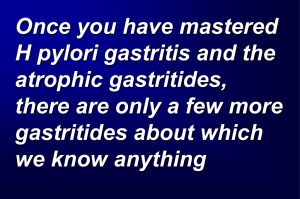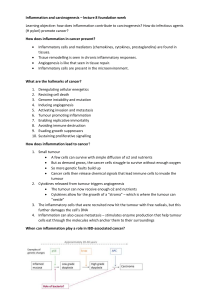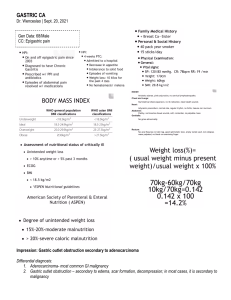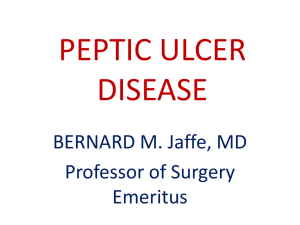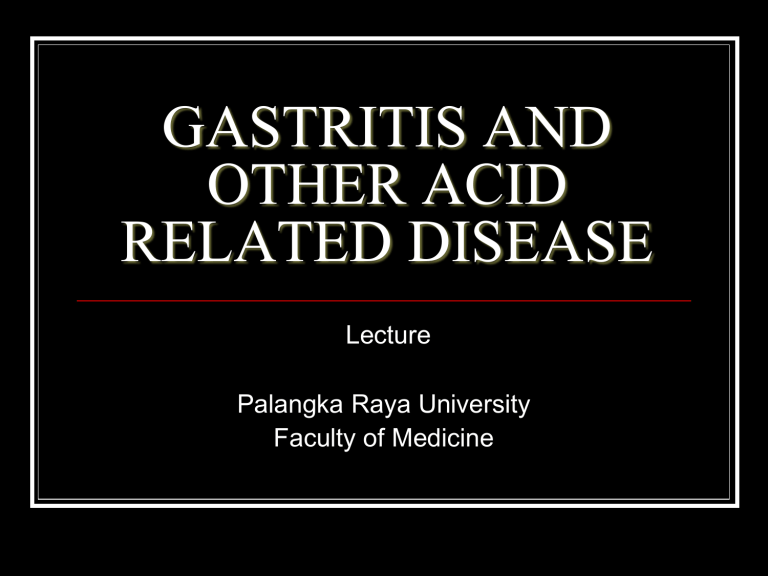
GASTRITIS AND OTHER ACID RELATED DISEASE Lecture Palangka Raya University Faculty of Medicine GASTRITIS Histologically documented inflammation of gastric mucosa not the mucosal erythema seen during endoscopy and not interchangeable with dyspepsia Classification Acute or chronic Histologic features Anatomical distribution or proposed pathogenic mechanism GASTRITIS ACUTE GASTRITIS Most common cause is infection H. pylori acute gastritis has not been extensively studied Sudden onset of epigastric pain, nausea, vomiting Mucosal histologic studies demonstrate a marked infiltrate of neutrophils with edema and hyperemia. If not treated chronic gastritis Hypochlorhydria lasting for up to 1 year may follow acute H. pylori infection ACUTE GASTRITIS Other causes of bacterial infection are rare due to acidic environment of the stomach Other types of infectious gastritis may occur in immunocompromised individuals such as AIDS patients CHRONIC GASTRITIS Identified histologically by an inflammatory cell consisting of lymphocytes and plasma cell with scanty neutrophil Patchy, superficial and glandular inflammation severe glandular destruction, atrophy and metaplasia Intestinal metaplasia - conversion of gastric glands into a small intestinal phenotype with small bowel mucosal glands containing goblet cells Intestinal metaplasia gastric cancer CHRONIC GASTRITIS Phases of chronic gastritis 1. Superficial gastritis - early phase, inflammatory changes limited to the lamina propria of the surface mucosa, with edema and cellular infiltrates separating intact gastric glands 2. Atrophic gastritis - inflammatory infiltrate extends deeper into the mucosa with progressive distortion and destruction of glands 3. Gastric atrophy - glandular structures are lost, with paucity of inflammatory infiltrates - thin mucosa with clear visualization of underlying vessels endoscopically CHRONIC GASTRITIS Normal Superficial gastritis Gastric atrophy CHRONIC GASTRITIS Classified according to predominant site of involvement Type A - Body predominant form (autoimmune) Type B - Antral predominant form (H. pylori-related) AB gastritis - mixed antral and body CHRONIC GASTRITIS Type A Gastritis (Autoimmune gastritis) Involves primarily the fundus and body, with antral sparing Associated with Pernicious anemia in the presence of circulating antibodies against parietal cell and Intrinsic factor Parietal cell containing gastric gland is the preferential target Parietal cell antibody is directed against H+,K+-ATPase Leads into achlorydia Destruction of parietal cell decrease Intrinsic Factor Vitamin B 12 (Cobalamin) deficiency Vitamin B 12 deficiency (megaloblastic anemia, neurologic dysfunction) Patients with Pernicious anemia may also have vitiligo, Addison’s disease, thyroiditis, hypoparathyroidism CHRONIC GASTRITIS Type A Gastritis Hypergastrinemia due to achlorydia and sparing of antral mucosa where G cells are located May lead to gastric carcinoid tumor due to the gastrin trophic effect of ECL cell hyperplasia Positive effect Gastrin CHRONIC GASTRITIS Type B Gastritis Antral-predominant More common than Type A Gastritis H. pylori infection Converts to pangastritis over time Risk for gastric adenocarcinoma due to metaplasia brought about by chronic H. pylori induced gastritis H. pylori infection is also associated with low-grade B cell lymphoma (gastric MALT lymphoma) Eradication of H. pylori may result in complete regression of tumor High grade lymphoma is unresponsive to H. pylori eradication CHRONIC GASTRITIS Treatment aimed at the sequelae and not the underlying inflammation Patients with pernicious anemia will require parenteral vitamin B12 supplementation on a long-term basis Eradication of H. pylori infection ZOLLINGER-ELLISON SYNDROME (ZES) Gastric acid hypersecretion due to unregulated GASTRIN release from a non – B cell endocrine tumor (Gastrinoma) Gastrinomas are classified as sporadic tumor or associated with Multiple Endocrine Neoplasia (MEN) type 1 syndrome Results into aggressive and refractory ulceration More common in male than female Majority are diagnosed 30-50 years old 0.1 to 1.0% incidence with individuals presenting with PUD Mostly malignant (>60%) and 30-50 % have mutiple or metastatic lesion upon diagnosis ZOLLINGER-ELLISON SYNDROME (ZES) Pathophysiology Hypergastrinemia from endocrine tumor stimulates acid secretion through gastric receptors on parietal cell and by inducing histamine release from ECL cells Hypergastrinemia leads to increased gastric acid secretion through parietal cell stimulation and increased parietal cell mass Increase gastric acid output leads to PUD, erosive esophagitis and diarrhea ZOLLINGER-ELLISON SYNDROME (ZES) Tumor distribution (80% are found w/in the gastrinoma triangle) Confluence of the cystic duct and common bile duct superiorly, junction of the second and third portion of the duodenum inferiorly and junction of the neck and body of the pancreas medially Significant number of lesions are extrapancreatic Duodenum (50-75% of non-pancreatic lesion) Less common site: stomach, bones, ovaries, heart, liver, lymph nodes ZOLLINGER-ELLISON SYNDROME (ZES) Clinical Manifestation Peptic ulcer - most common Unusual ulcer location (second part of the duodenum and beyond) Ulcer refractory to standard medical therapy Ulcer recurrence after acid-reducing surgery Mild esophagitis to frank ulceration with stricture and Barrett’s mucosa ZOLLINGER-ELLISON SYNDROME (ZES) Clinical Manifestation Diarrhea - 2nd most common Marked volume overload to small intestine Pancreatic enzyme inactivation by acid Damage of intestinal epithelial surface by acid which leads to maldigestion and malabsorption of nutrients Secretory component due to direct stimulatory effect of gastrin on enterocytes or co-secretion of additional hormones from tumor such as Vasoactive Intestinal Peptide (VIP) ZOLLINGER-ELLISON SYNDROME (ZES) ZOLLINGER-ELLISON SYNDROME (ZES) Gastrinoma associated MEN 1 Syndrome (parathyroid + pancreas + pituitary gland) Autosomal dominant disorder Long arm of chromosome 11 (11q11-q13) Associated with hypercalcemia direct secretory effect on gastric secretion Parathyroidectomy reduces gastrin and gastric acid output Higher incidence of gastric carcinoid tumor development compared to sporadic ZES Smaller, multiple and more often located at the duodenal wall compared to sporadic ZES ZOLLINGER-ELLISON SYNDROME (ZES) Diagnosis A. Obtained a biochemical diagnosis 1. Elevated fasting gastrin level (>150-200 pg/mL) Normal FG <150pg/mL Other causes of elevated gastrin H. pylori infection Used of anti-secretory agents for ulcer Fasting gastrin 10x above normal suggest ZES ZOLLINGER-ELLISON SYNDROME (ZES) When to Obtain a Fasting Serum Gastrin Level Multiple ulcers Ulcers in unusual locations; associated with severe esophagitis; resistant to therapy with frequent recurrences; in the absence of NSAID ingestion or H. pylori infection Ulcer patients awaiting surgery Extensive family history for peptic ulcer disease Postoperative ulcer recurrence Basal hyperchlorhydria Unexplained diarrhea or steatorrhea Hypercalcemia Family history of pancreatic islet, pituitary, or parathyroid tumor Prominent gastric or duodenal folds ZOLLINGER-ELLISON SYNDROME (ZES) Diagnosis 2. Elevated acid secretion measurement (BAO/MAO > 0.6) basal gastric pH > 3 virtually excludes a gastrinoma 3. Gastrin provocative test (Secretin study) developed in an effort to differentiate between the causes of hypergastrinemia and are especially helpful in patients with indeterminate acid secretory studies most sensitive and specific gastrin provocative test for the diagnosis of gastrinoma increase in gastrin of 120 pg within 15 min of secretin injection has a sensitivity and specificity of >90% for ZES ZOLLINGER-ELLISON SYNDROME (ZES) B. Tumor localization after biochemical diagnosis ZOLLINGER-ELLISON SYNDROME (ZES) Octreoscan (Nuclear Imaging that utilizes a Somatostatin analogue) Several endocrine tumors (i.e. Gastrinoma) express cell-surface receptors for Somatostatin Localization of gastrinomas by measuring the uptake of the stable Somatostatin analogue ZOLLINGER-ELLISON SYNDROME (ZES) Treatment Ameliorating signs and symptoms related to hormone overproduction High dose proton pump inhibitor Somatostatin analogue (Octreotide) as adjunct - inhibitory effects on gastrin release from receptor-bearing tumors and inhibits gastric acid secretion to some extent Definitive cure Surgical resection led to immediate cure rates as high as 60% 10 year disease free survival as high as 34% in sporadic gastrinoma Only 6% of MEN 1 patients are disease free 5 years after surgery ZOLLINGER-ELLISON SYNDROME (ZES) Outcome Complete tumor resection (5-10 year survival rate of >90%) Incomplete tumor resection (5-10 year survival rate of 43% and 25% respectively) Hepatic metastasis (< 20% 5 year survival rate) Poor outcome factors: shorter disease duration; higher gastrin level (>10,000 pg/mL); large pancreatic primary tumor (>3cm); metastatic disease to lymph nodes and bone; and Cushing’s disease Favorable outcome factors: primary duodenal wall tumor; isolated lymph node tumor, undetectable tumor upon surgical exploration STRESS- RELATED MUCOSAL INJURY STRESS- RELATED MUCOSAL INJURY Stressors shock, sepsis, massive burns, severe trauma, head injury can cause acute erosive gastric mucosal changes or frank ulceration with bleeding Mucosal injury commonly seen in the acid producing portion of the stomach (fundus and body) Most common presentation is GI bleeding which usually occur 4872 h after acute injury Risk factor for bleeding Patient on mechanical ventilator Underlying coagulopathy STRESS- RELATED MUCOSAL INJURY Pathophysiology Mucosal ischemia Breakdown of normal protective barriers of stomach Acid Curling’s ulcer - severe burn Cushing’s ulcer - head trauma Proton pump inhibitor Treatment of choice for stress prophylaxis Maintain gastric pH > 3.5 OTHER FORMS OF GASTRITIS Lymphocytic gastritis is characterized histologically by intense infiltration of the surface epithelium with lymphocytes infiltrative process is primarily in the body of the stomach and consists of mature T cells and plasmacytes. A subgroup of patients have thickened folds noted on endoscopy. These folds are often capped by small nodules that contain a central depression or erosion; this form of the disease is called varioliform gastritis. Varioliform gastritis OTHER FORMS OF GASTRITIS Eosinophilic gastritis Marked eosinophilic infiltration involving any layer of the stomach (mucosa, muscularis propria, and serosa) Clinical manifestation of systemic allergy Affected individuals will often have circulating eosinophilia Antral involvement predominates, with prominent edematous folds being observed on endoscopy Prominent antral folds can lead to outlet obstruction. Treatment with glucocorticoids has been successful OTHER FORMS OF GASTRITIS Granulomatous gastritis Crohn's disease Involvement may range from granulomatous infiltrates noted only on gastric biopsies to frank ulceration and stricture formation. Occurs in the presence of small-intestinal disease. OTHER FORMS OF GASTRITIS Granulomatous gastritis Several rare infectious processes that can lead to granulomatous gastritis histoplasmosis, candidiasis, syphilis, and tuberculosis sarcoidosis, idiopathic granulomatous gastritis, and eosinophilic granulomas involving the stomach OTHER FORMS OF GASTRITIS Ménétrier's Disease Rare disease Characterized by large, tortuous gastric mucosal folds mostly in the fundus and body Histologically, massive foveolar hyperplasia (hyperplasia of surface and glandular mucous cells) is noted which replaces most of the chief cell and parietal cell Over expression of growth factors such as TGF may be involved in the process Twenty to 100% of patients (depending on time of presentation) develop a protein-losing gastropathy accompanied by hypoalbuminemia and edema. OTHER FORMS OF GASTRITIS Ménétrier's Disease OTHER FORMS OF GASTRITIS Ménétrier's Disease Diagnosis Medical Treatment Large gastric folds on barium swallow and endoscopy (do biopsy) Anticholinergics decrease protein loss High protein diet Ulcers should be treated with a standard approach Surgical Severe disease with persistent and substantial protein loss may require total gastrectomy END

